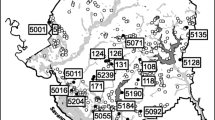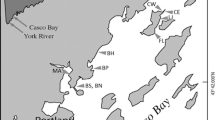Abstract
Limesink wetlands are a common aquatic habitat in southwest Georgia, USA. These wetlands are non-alluvial, occupying shallow depressions formed from dissolution of limestone bedrock and collapse of surface sands. They are seasonally inundated, with a typical hydroperiod extending from late February to early July. Little is known about factors influencing invertebrate community structure in limesink wetlands. Recently, it has been suggested that regular inundation and drying are important influences on community structure in some seasonal wetlands. We had an opportunity to examine this hypothesis in 3 forested limesink wetlands. Quantitative samples of invertebrates were taken monthly on benthic and wood surfaces from March 1994 through July 1995. This included a period of unusually heavy precipitation, summer and autumn of 1994, when the wetlands would normally be dry. Immediately following inundation, benthic samples were dominated by amphipods (Crangonyx sp.), isopods (Caecidotea sp.), cladocerans, and copepods. Maximum total densities (1000–4000 individuals per m2) were observed within 3 months of inundation. During summer and autumn, densities decreased (< 500 individuals per m2), and the benthos was dominated by larval chironomids. Wood surfaces were dominated by chironomids, with greatest densities (1000–3000 individuals per m2) observed in summer and autumn. Although not quantified, freshwater sponge became very abundant on wood surfaces during autumn. During the following spring (1995), invertebrate densities on sediments remained low, and few amphipods, isopods, cladocerans, or copepods were collected. Chironomids remained very abundant on wood. Our results suggest that extended inundation is a disturbance to some elements of wetland invertebrate communities. Extended inundation may cause short-term reductions in populations by eliminating summer refugia (amphipoda, isopoda) or by altering environmental cues necessary for the completion of life cycles (cladocerans, copepods).
Similar content being viewed by others
Literature Cited
Allard, D. J. 1990. Southeastern United States Ecological Community Classification, Interim Report, Version 1.2. The Nature Conservancy, Southeast Regional Office, Chapel Hill, NC, USA.
Batzer, D. P. and S. A. Wissinger. 1996. Ecology of insect communities in nontidal wetlands. Annual Review of Entomology 41:75–100.
Beck, B. F. and D. D. Arden. 1983. Hydrology and Geomorphology of the Dougherty Plain, Southwest Georgia. Scutheastern Geological Society, Tallahassee, FL, USA.
Benke, A. C., R. L. Henry III, D. M. Gillespie, and R. J. Hunter. 1985. Importance of snag habitat for animal production in southeastern stream. Fisheries 10:8–13.
Butler, M. G. and D. H. Anderson. 1990. Cohort structure, biomass, and production of a merovoltineChironomus population in a Wisconsin bog lake. Journal of the North American Benthological Society 9:180–192.
Day, F. P. Jr. 1979. Litter accumulation in four plant communities in the Dismal Swamp, Virginia. The American Midland Naturalist 102:281–289.
Dodd, C. K. 1992. Biological diversity of a temporary pond herpetofauna in north Florica sandhills. Biodiversity and Conservation 1:125–142.
Dodd, C. K. 1995. Reptiles and amphibians in the endangered longleaf pine ecosystem. p. 129–131.In E. T. LaRoe, G. S. Farris, C. E. Puckett, P. D. Doran, and M. J. Mac (eds.). Our Living Resources: A Report to the Nation on the Distribution, Abundance, and Health of U.S. Plants, Animals, and Ecosystems, U.S. Department of Interior—National Biological Service. Washington, DC, USA.
Duffy, W. G. and D. J. LaBar. 1994. Aquatic invertebrate production in southeastern USA wetlands during winter and spring. Wetlands 14:88–97.
Gladden, J. E. and L. A. Smock. 1990. Macroinvertebrate distribution and production on the floodplains of two lowland headwater streams. Freshwater Biology 24:533–545.
Halpern, C. B. 1988. Early successional pathways and the resistance and resilience of forest communities. Ecology 69:1703–1715.
Hax, C. L. and S. W. Golladay. 1993. Macroinvertebrate colonization and biofilm development on leaves and wood in a boreal river. Freshwater Biology 29:79–87.
Hayes, L. R., M. L. Maslia, and W. C. Meeks. 1983. Hydrology and Model Evaluation of the Principal Artesian Aquifer, Dougherty Plain, Southwest Georgia. Georgia Geological Survey Bulletin 97.
Hendricks, E. L. and M. H. Goodwin. 1952. Water-Level Fluctuations in Limestone Sinks in Southwestern Georgia. Geological Survey Water Supply Paper 1110-E.
Lake, P. S., A. E. Bayly, and D. W. Morton. 1989. The phenology of a temporary pond in western Victoria, Australia, with special reference to invertebrate succession. Archiv fur Hydrobiologie 115:171–202.
Lynch, J. M., A. K. Gholson Jr., and W. W. Baker. 1986. Natural Features Inventory of Ichauway Plantation, Georgia: Volume I. The Nature Conservancy Southeast Regional Office. Chapel Hill, NC, USA.
Merritt, R. W. and K. W. Cummins. 1984. An Introduction to the Aquatic Insects of North America. Kendall/Hunt Publishing Company, Dubuque, IA, USA.
Mitsch, W. J. and J. G. Gosselink. 1993. Wetlands. Van Nostrand Reinhold, New York, NY, USA.
Neckles, H. A., H. R. Murkin, and J. A. Cooper. 1990. Influences of seasonal flooding on macroinvertebrate abundance in wetland habitats. Freshwater Biology 23:311–322.
palmer, M. A., P. Arensburger, P. S. Botts, C. C. Hakenkamp, and J. W. Reid. 1995. Disturbance and the community structure of stream invertebrates: patch-specific effects and the role of refugia. Freshwater Biology, 34:343–356.
Pennak, R. W. 1989. Fresh-water Invertebrates of the United States: Protozoa to Mollusca. John Wiley and Sons, Inc., New York, NY, USA.
Sklar, F. H. 1985. Seasonality and community structure of the backswamp invertebrates in a Louisiana cypress-tupelo wetland. Wetlands 5:69–86.
Sokal, R. R. and F. J. Rohlf. 1995. Biometry, 3rd Edition. W.H. Freeman, New York, NY, USA.
Sutter, R. D. and R. Kral. 1994. The ecology, status, and conservation of two non-alluvial wetland communities in the South Atlantic and Eastern Gulf Coastal Plain, USA. Biological Conservation 68:235–243.
Tansey, J. B. and N. D. Cost. 1990. Estimating the forested-wetland resource in the southeastern United States with forest survey data. Forest Ecology and Management, 33/34:193–213.
Taylor, B. E., R. A. Estes, J. H. K. Pechmann, and R. D. Semlitsch. 1988. Trophic relations in a temporary pond: larval salamanders and their microinvertebrate prey. Canadian Journal of Zoology 66:2191–2198.
Taylor, B. E., D. L. Mahoney, and R. A. Estes. 1989. Zooplankton production in a carolina bay. p. 425–435.In R. R. Sharitz and J. W. Gibbons (eds.) Freshwater Wetlands and Wildlife. USDOE Office of Scientific and Technical Information, Oak Ridge, TN, USA.
Thorp, J. H., E. M. McEwan, M. F. Flynn, and F. R. Hauer. 1985. Invertebrate colonization of submerged wood in a Cypress-Tupelo swamp and blackwater stream. The American Midland Naturalist 113:56–68.
Torak, L. J., G. S. Davis, G. A. Strain, and J. G. Herndon. 1991. Geohydrology and evaluation of water-resource potential of the upper Floridan Aquifer in the Albany area, Southwest Georgia. U.S. Geological Survey Open-File Report 91–52.
Watson, G. F., M. Davies, and M. J. Tyler. 1995. Observations on temporary waters in northwestern Australia. Hydrobiologia 299:53–73.
Webster, J. R., J. B. Waide, and B. C. Patten. 1975. Nutrient recycling and the stability of ecosytems. p 1–27.In F. G. Howell, J. B. Gentry, and M. H. Smith (eds.) Mineral Cycling in Southeastern Ecosystems, ERDA Symposium Series Conf-740513. Washington, DC, USA.
Wharton, C. H. 1978. The Natural Environments of Georgia. Georgia Department of Natural Resources. Altanta, GA, USA.
Wiggins, G. B., R. J. Mackay, and I. M. Smith. 1980. Evolutionary and ecological strategies of animals in annual temporary pools. Archiv fur Hydrobiologie Supplement 58:97–206.
Williams, W. D. 1985. Biotic adaptations in temporary lentic waters, with special reference to those in semi-arid and arid regions. Hydrobiologia 125:85–110.
Ziser, S. W. 1978. Seasonal variations in water chemistry and diversity of the phytophilic macroinvertebrates of three swamp communities in southeastern Louisiana. The Southwestern Naturalist 23:545–562.
Author information
Authors and Affiliations
Rights and permissions
About this article
Cite this article
Golladay, S.W., Taylor, B.W. & Palik, B.J. Invertebrate communities of forested limesink wetlands in southwest Georgia, USA: Habitat use and influence of extended inundation. Wetlands 17, 383–393 (1997). https://doi.org/10.1007/BF03161428
Received:
Revised:
Accepted:
Issue Date:
DOI: https://doi.org/10.1007/BF03161428




